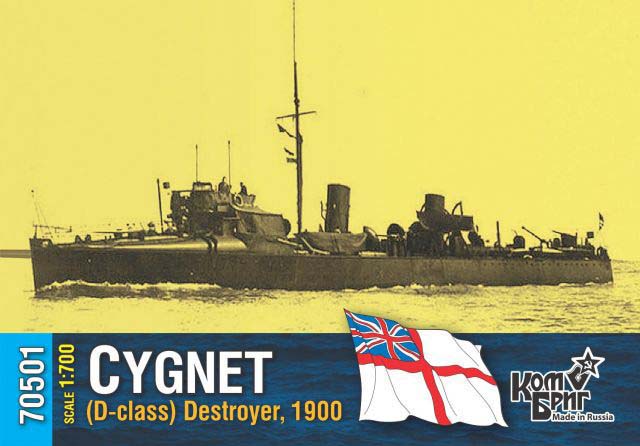1/700 HMS Cygnet 1900


|
by Martin J Quinn |
| HISTORY |
| HMS Cygnet was a D-class destroyer, a fairly
homogeneous group of torpedo boat destroyers (TBDs) built for the Royal
Navy in the mid-1890s. They were all constructed to the individual designs
of their builder, Thornycroft & Company, to meet Admiralty specifications.
The uniting feature of the class was a top speed of 30 knots, with two
funnels.
In 1913 the 30 knot vessels with two funnels were re-classified by the Admiralty as the "D" class, to provide some system to the naming of HM destroyers. At the same time, those with three funnels were classified as the "C" class and those with four funnels as the "B" class. All these vessels had a distinctive "turtleback" forecastle that was intended to clear water from the bow, but actually tended to dig the bow in to anything of a sea, resulting in a very wet conning position. They were better constructed than their A-class forebears (the "26 knotter" and "27 knotter" groups), but still were poor seaboats unable to reach top speed in anything but perfect conditions. HMS Cygnet was ordered by the Royal Navy under the 1896 – 1897 Naval Estimates. The thirteenth ship to carry this name, she was launched in 1898, served in the Chatham division before World War I and was tendered to the gunnery school at Sheerness during the war. She was sold for breaking up in 1920. For further information, check out the Wikipedia page (where this information came from) for her class here. There is no mention of Cygnet in Norman Friedman's "British Destroyers, From the Earliest Days to the Second World War", though there is a line drawing of her predecessor Desperate. |
| The Combrig Cygnet
Cygnet is packaged in a thin, white cardboard box, with a photo of the real vessel on the box top. Inside the box is the hull in one bag, and four runners, consisting of almost 60 parts in a second bag. These are all secured with packaging peanuts. The small parts were all in a single bag. Fortunately, none of the parts came off the resin runners or were broken. |
|||||||||||||||||
|
|||||||||||||||||
| THE HULL | |||||||||||||||||
| This is a traditional 700 waterline
model, with no lower hull. According to the measurements I found
for
Cygnet, the hull scales out pretty much perfectly in both beam
and length. The upper portion of the hull is very well cast
with lots of good detail. There are some faint lines on the
deck and on the starboard side of the hull. This may be carry over
from the master, if it was 3D printed. For the first
time in a Combrig kit that I've reviewed, I found a large piece of resin
over pour, which is on the stern of the ship. It also
appears that the bottom of the hull will need to be sanded to remove additional
over pour.
The hull of the Cygnet is not a re-pop of other Combrig early Royal Navy destroyers. It's quite different from both the early Ardent and later Spitfire, as seen in the photos below. |
|||||||||||||||||
|
|||||||||||||||||
| SMALLER PARTS | |||||||||||||||||
| There are five resin runners in the kit. This is where you will find the funnels, guns, torpedo tubes, vents, boats and anchors, along with other small parts. All these smaller parts are very good, the casting is really well done. The guns and torpedo tubes are really well cast. The davits and anchors are especially thin and delicately cast. | |||||||||||||||||
|
|||||||||||||||||
| PHOTOETCH | |||||||||||||||||
| There is no photo-etch included with
the kit. You will have to source your own railings.
Nor are there are any masts included with the kit. As per usual Combrig practice, there are drawings showing dimensions of the masts and yards. |
|||||||||||||||||
| INSTRUCTIONS | |||||||||||||||||
| The instructions are typical Combrig
fare, just on a much smaller scale. As with the previously reviewed
Ardent
kit, I'd call them "minimalist". They are one side of one piece
of paper, with a list the parts and two exploded views showing where to
place the parts. There is no plan and profile view of Cygnet
included, nor are there color callouts or painting instructions, but the
box would seem to indicate a she was all black.
Instructions continue to be one of the weaker parts of Combrig's kits. |
|||||||||||||||||
|
|||||||||||||||||
| CONCLUSIONS | |||||||||||||||||
 Combrig
continues to release kits of the earliest British torpedo boat destroyers.
This is a good little kit, who's small size and smaller part count should
make it a relatively quick project. This kit is recommended
for fans of small combatants and/or fans of 19th century British warships.
The only issue I found with it is the surprising over pour on the stern,
which was very Combrig
continues to release kits of the earliest British torpedo boat destroyers.
This is a good little kit, who's small size and smaller part count should
make it a relatively quick project. This kit is recommended
for fans of small combatants and/or fans of 19th century British warships.
The only issue I found with it is the surprising over pour on the stern,
which was very
un-Combrig like. I'd also like to see Combrig continue to improve their packaging, and bag the smaller parts separately from each other. This is Combrig’s 1/700 USS Cygnet, kit number 70501. The model lists for $19.95 and is available from many of our fine sponsors. This is an in-box review. While the model seems to compare nicely to photos and the drawing of her early classmate Desperate, your mileage may vary once you commence construction. Thanks to Combrig Models for the review sample. |
|||||||||||||||||
